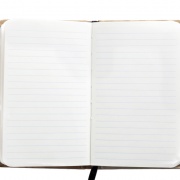Fear of the Blank Page Part I: Breaking Through the Block
Date
I have been writing for most of my professional life: first as a journalist and art critic, then as an advertising copywriter, and then as a middle-grade author (the Circles of Heck series). My work as a children’s author has me visiting schools and giving writing workshops regularly, helping young writers (especially reluctant writers) to open up and hone their craft so that they can tell the stories dormant within!
Many young writers find it easy to get frustrated as they begin writing. One major roadblock is, of course, spelling and grammar. Handwriting can also prove to be a challenge if a student’s ideas come faster than their hand’s ability to keep up. Considering the expectations of the reader—i.e. the teacher— is another. But, as I see it, the most formidable obstacle facing writers is this:

Yes, the blank page! A student knows that their writing should be brimming with fascinating concepts, their stories dynamic and engrossing, and their writing style crisp and clear, yet with these requirements in place, the ability to express one’s thoughts on the page can often seem—quite understandably—an impossible task.
Get Lost and Get Writing
Writing is a little like driving, where if you think about the process too much—how dangerous and weird it really is—then you’re toast. The key is to get lost in it (writing, not driving), which takes space and intention. In this way, ideas can bubble to the surface.
Writing is an attempt to will something interesting into existence. One way of doing this is to begin writing by not writing and, instead, daydreaming. Sure, this can often look a lot like sleeping (sometimes so much so that it actually is sleeping, which isn’t writing so much as resting) but daydreaming can help a writer to better arrange their thoughts. Most school writing programs don’t allow for this necessary first step, which is understandable, as it’s not really quantifiable writing time. But it’s essential. Otherwise, it’s like running without stretching first. By allowing a student time to first think about what they may write, then the process of writing is merely about keeping up with their thoughts, not staring at a painfully blank page.
If You Love Writing, Set It Free
For educators, the initial phase of a student writing session should be about “opening up” and capturing ideas on paper with no expectations: just enjoying the process. Spelling and grammar are not important at this stage. It’s about braving the emptiness, having fun and being “free.”
Making sense of free writing comes later in the “honing” phase. This is when clutter is removed and the unique voice and perspective in a student’s writing is truly revealed. Honing is where the other part of a writer’s brain clicks in—the critic—and a student works to strengthen their statements and solidify their stories. While essential later on, a critic has no business interfering in the free writing stage.
Writing prompts are a powerful way of getting creative juices flowing to overcome the popular “I don’t know what to write about!” excuse. Some ideas include:
• What’s the scariest thing that has ever happened to you?
• If you could have any superpower, what would it be?
• What would you do if you ruled the world?
• What three things would you want with you on a desert island? What person would you want to be stranded with and why?
• What’s the best present you ever received and why?
• What would happen if you woke up one morning and you were your teacher? Or your parents?
Scholastic has a fun tool called Story Starters that provides interactive prompts to get young minds mulling. Students can choose a theme, type in their name, pick their grade, and they’re off and writing!
Another essential activity for budding writers is reading, as reading is a lot like writing, only in reverse. The rules of writing become subconsciously ingrained in a student’s mind so that they have a sense of how to proceed when writing their own stories. Linking a love of reading to a love of writing is an obvious connection for educators to make. Having students write “fan-fiction” of their favorite stories is another great way to help reluctant writers, as settings and characters have already been created and defined.
Part II of this blog post will cover more in-the-trenches strategies to help students to open up when writing. How do you help to set the stage for writing in your classroom?

